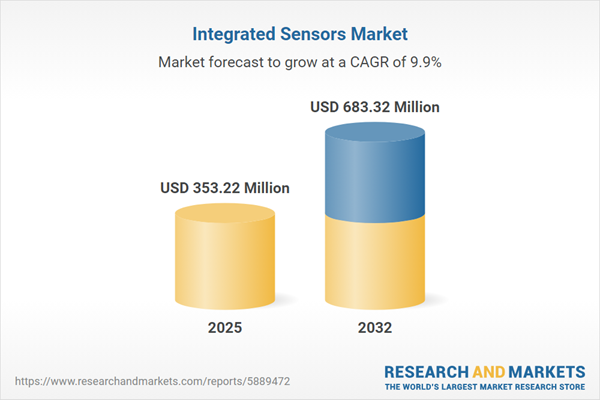Speak directly to the analyst to clarify any post sales queries you may have.
The integrated sensors market is rapidly evolving, driven by advances in miniaturization, signal processing, and seamless connectivity. As businesses seek to optimize operations and enable smarter decision-making, understanding key shifts and emerging opportunities in this sector is crucial.
Market Snapshot: Integrated Sensors Market Growth and Outlook
The Integrated Sensors Market grew from USD 321.36 million in 2024 to USD 353.22 million in 2025. It is expected to continue growing at a CAGR of 9.88%, reaching USD 683.32 million by 2032. Strong growth is catalyzed by the convergence of edge computing, artificial intelligence, and advanced semiconductor design. Industry stakeholders across industrial, healthcare, automotive, and consumer sectors are adopting integrated sensing to support transformation, system reliability, and scalable real-time analytics.
Scope & Segmentation: Technologies, Applications, and Regional Coverage
- Technology Platforms: Capacitive, CMOS, MEMS, Microfluidics, Optical, Piezoelectric
- Sensor Types: Biosensors, Chemical sensors, Humidity sensors, Motion sensors, Optical sensors, Pressure sensors, Proximity sensors, Temperature sensors
- Applications: Aerospace & Defense, Automotive (Autonomous Driving, Infotainment, Powertrain, Safety Systems), Consumer Electronics (AR/VR, Smart Home, Smartphones, Wearables), Energy & Utilities, Healthcare (Diagnostics, Imaging, Patient Monitoring, Wearable Devices), Industrial Automation (Machine Vision, Predictive Maintenance, Process Control, Robotics), Internet of Things (Asset Tracking, Environmental Monitoring, Smart Agriculture, Smart Cities)
- Output Signals: Analog, Digital, Mixed Signal
- Region Coverage: Americas (North America: United States, Canada, Mexico; Latin America: Brazil, Argentina, Chile, Colombia, Peru), Europe, Middle East & Africa (Europe: United Kingdom, Germany, France, Russia, Italy, Spain, Netherlands, Sweden, Poland, Switzerland; Middle East: United Arab Emirates, Saudi Arabia, Qatar, Turkey, Israel; Africa: South Africa, Nigeria, Egypt, Kenya), Asia-Pacific (China, India, Japan, Australia, South Korea, Indonesia, Thailand, Malaysia, Singapore, Taiwan)
- Key Companies: STMicroelectronics N.V., Bosch Sensortec GmbH, Texas Instruments Incorporated, Analog Devices, Inc., Infineon Technologies AG, NXP Semiconductors N.V., Murata Manufacturing Co., Ltd., TDK Corporation, Honeywell International Inc., TE Connectivity Ltd., Renesas Electronics Corporation
Key Takeaways for Senior Decision-Makers
- Adoption of integrated sensors is accelerating due to the demand for real-time data capture and advanced analytics across industries including automation, healthcare, and automotive.
- Innovations in semiconductor technology, particularly in MEMS, CMOS, and microfluidics, allow for more compact, energy-efficient, and multifunctional sensor platforms suited to both established and emerging applications.
- The shift toward on-device analytics and distributed intelligence at the edge enables improved latency, data privacy, and rapid autonomous response—a critical advantage for safety-critical and industrial environments.
- Standardization and interoperability are gaining traction, enabling seamless integration of multi-vendor sensor networks and simplifying deployment for complex, large-scale infrastructures.
- Regional supply chain strategies are evolving, with manufacturers strengthening domestic capabilities and forging regional partnerships to minimize disruption risk and optimize distribution efficiency.
- Key industry players are differentiating through strategic collaborations, investments in next-generation architectures, and continuous enhancement of integration between sensors, connectivity modules, and analytics software.
Tariff Impact on Supply Chain and Cost Structures
Recent United States tariffs on semiconductor and sensor component imports have affected global sourcing strategies. Manufacturers across substrates, assemblies, and optical modules are facing increased input costs. In response, industry participants are accelerating regional manufacturing, forming strategic partnerships, and revising procurement plans to protect supply continuity.
Research Methodology & Robust Data Sources
This report leverages a blend of confidential interviews with senior industry stakeholders, structured surveys, and comprehensive literature analysis, including technical publications, regulatory documents, and market reports. Quantitative data has been cleansed and validated, while workshops with domain experts provided qualitative depth and ensured accuracy.
Why This Report Matters for Strategic Planning
- Provides actionable intelligence on market segmentation, technology trends, and regional growth dynamics to guide investment and innovation strategy in the integrated sensors market.
- Equips leadership with insights to navigate evolving regulations, tariffs, and supply chain risks, supporting proactive risk management and market positioning.
- Enables evaluation of competitive moves and partnership opportunities, offering a foundation for long-term, resilient operational models.
Conclusion
The integrated sensors market is being reshaped by technology convergence, new regulatory frameworks, and shifting supply chain strategies. Organizations equipped with these insights can capitalize on innovation, enhance resilience, and achieve sustainable growth in an evolving global landscape.
Additional Product Information:
- Purchase of this report includes 1 year online access with quarterly updates.
- This report can be updated on request. Please contact our Customer Experience team using the Ask a Question widget on our website.
Table of Contents
3. Executive Summary
4. Market Overview
7. Cumulative Impact of Artificial Intelligence 2025
Companies Mentioned
The companies profiled in this Integrated Sensors market report include:- STMicroelectronics N.V.
- Bosch Sensortec GmbH
- Texas Instruments Incorporated
- Analog Devices, Inc.
- Infineon Technologies AG
- NXP Semiconductors N.V.
- Murata Manufacturing Co., Ltd.
- TDK Corporation
- Honeywell International Inc.
- TE Connectivity Ltd.
Table Information
| Report Attribute | Details |
|---|---|
| No. of Pages | 184 |
| Published | October 2025 |
| Forecast Period | 2025 - 2032 |
| Estimated Market Value ( USD | $ 353.22 Million |
| Forecasted Market Value ( USD | $ 683.32 Million |
| Compound Annual Growth Rate | 9.8% |
| Regions Covered | Global |
| No. of Companies Mentioned | 11 |









